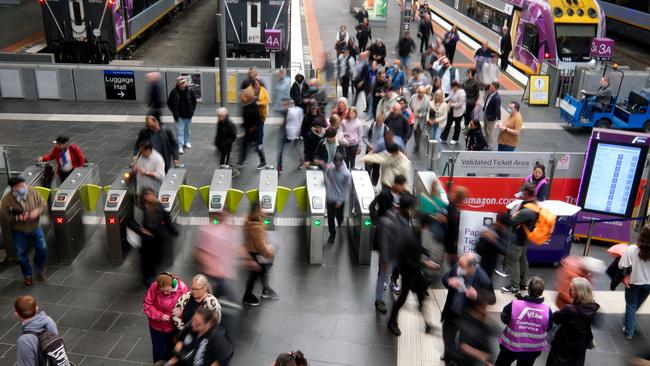Resilient jobs market means RBA won’t rush to cut interest rates
Interest rate relief for struggling households looks some way off as Australia’s tight labour market gives the Reserve Bank no urgency to cut rates amid stubbornly high inflation.

Interest rate relief for struggling households looks some way off as Australia’s tight labour market gives the Reserve Bank no urgency to cut rates amid stubbornly high inflation.
The chance of rate cuts improved slightly after lower-than-expected US inflation data sparked a fall in global bond yields despite a less-dovish outlook from US policy makers after their meeting.
But a 25 basis point cut by the RBA isn’t fully expected by the money market until May 2025.
Three of the four major banks still expect the central bank to cut rates in November.
However, after ANZ Bank shifted its call to February this week, Australian labour force data for May didn’t suggest the RBA should cut rates any sooner than the mid-2025 assumption used in its latest forecasts that inflation would not reach the midpoint of its 2-3 per cent target band until mid-2026.
As expected by most economists and consistent with the RBA’s forecasts, the unemployment rate slipped to 4 per cent last month as employment rose by almost 40,000. Some of the rise in jobs and fall in unemployment reflected an unusual pattern of people starting jobs that they were waiting to start the previous month. However, the Australian Bureau of Statistics said the labour market “remains relatively tight, though less than in late 2022 and early 2023”.
Australia’s unemployment rate has risen from a 50-year low of 3.5 per cent in October 2022 and will hit 4.3 per cent by mid-2025 according to the RBA. However, it is currently below the so-called non-accelerating inflation rate of unemployment, which the Bank has pegged at 4.3 per cent.
“This is consistent with a soft landing – no forward indicator is suggesting a material deterioration in the labour market,” Citi Australia chief economist Josh Williamson said.
“Consequently, there is no need for a dovish tilt from the RBA in the near-term, especially with inflation still sticky and showing no signs of declining more rapidly.”
Mr Williamson added that with the ratio of employment to the working age population near a record high “jobs growth is not being outpaced by population growth”.
“In other words, labour demand is able to meet labour supply that has been rising because of working age migration growth,” he said.
“This has kept the unemployment rate tightly range-bound around 4 per cent, below the RBA’s 4.3 per cent estimate of NAIRU.
“Furthermore, 80 per cent of job gains this year have been full-time.”
Williamson said the solid jobs market appears to be having an “encouraged worker effect”, particularly on males. While female participation remains close to an all-time high at 62.7 per cent, male participation has increased by 0.4 percentage points this year to 71 per cent.
A 0.5 per cent fall in aggregate hours worked last month wasn’t a sign of labour market weakness.
The ABS said some of the reduction in hours worked last month reflected more employed people than usual working reduced hours because they were sick.

With the RBA’s cash rate at a “restrictive” 4.35 per cent since November, the economy has added a solid 203,000 jobs amid demand for services, and was “acclimating to higher official interest rates”, according to Citi’s Williamson.
He expects jobs growth to slow in the second half of this year to around 2.25 per cent per annum from the current pace of 2.5 per cent, which should see the unemployment rate reach 4.3 per cent.
But he saw “no evidence of a material deterioration in the labour market”.
“The RBA’s full-suite of employment indicators would suggest that while the labour market has loosened, it remains tight, and with lingering sticky inflation, we continue to expect no changes to the cash rate this year,” he added.
Royal Bank of Canada chief economist Su-Lin Ong agreed Australia’s labour market remains tight, with the pace of job growth rising since last year, the unemployment rate steady around 4 per cent for the last six months, and the number of hours worked rising since December.
“The labour market has loosened from its tightest point of 2022/23 when the unemployment rate was testing 50-year lows but it has broadly continued to absorb the increasing supply of labour and remains both healthy and still tight,” Ms Ong said.
While leading indicators point to some moderation in employment generation consistent with the sub-trend pace of economic activity, she said the labour market “looks pretty resilient”.
Moreover, a further loosening of the labour market remains key for the RBA with labour costs a main contributor to the elevated and more persistent services and domestically generated inflation.
“The continued easing in unit labour costs and compensation of employees evident in the national accounts would have been welcome but they remain high at 6.9 per cent and 7.1 per cent year-on-year respectively,” she added.
With measures of core and services inflation running at more than 4 per cent per annum and the lagging nature of labour costs in inflation, the RBA will need to see sustained signs of further labour market loosening and lower unit labour costs before cutting interest rates.
Overall, labour market data suggest the RBA shouldn’t need to hike any further, but most indicators are “a long way from signalling a shift to a less restrictive policy stance”.
Betashares chief economist David Bassanese said the latest jobs data showed the economy is “slowly but surely losing its ability to absorb the immigration fuelled gains in labour supply”.
“As in the US, the slow gradual rise in the unemployment rate is consistent with the ‘Goldilocks’ or ‘soft landing’ scenario markets have long been hoping for,” he said.
“Consistent with such glacial labour market slowing, wage growth is also slowing in both economies, which strongly suggests service inflation will also ease further and the next move in US and Australian official rates will be down.”
But with federal government tax cuts and subsidies starting next month and most state governments also unleashing stimulatory budgets aiming to counter cost of living pressure, fiscal policy is countering the RBA’s aim to keep a lid on consumer spending and prices, Bassanese added.







To join the conversation, please log in. Don't have an account? Register
Join the conversation, you are commenting as Logout